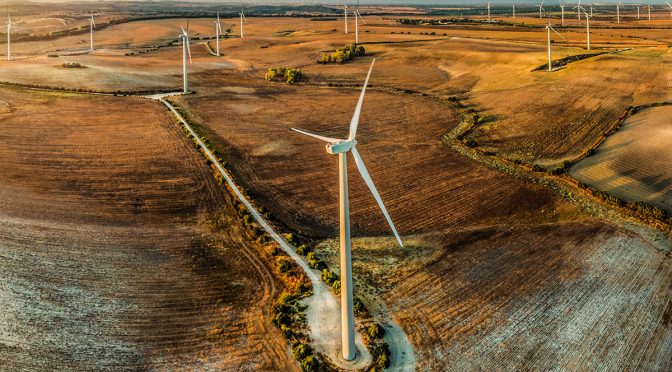Renewables represent 44% of the national total and increase their generation by 12.8% compared to 2019. The CO2 equivalent emissions associated with the production of electricity are reduced by 27.8%, reaching the lowest value since records are available (2007).
53.8% of the Spanish generation park is renewable, with wind energy being the first technology installed in our country.
The pandemic contracts electricity demand in Spain during 2020, which decreases 5.6% compared to the previous year.
Renewables produced 44% of total energy in Spain in the last year and made 2020 the greenest year since there are national records (2007). In total, 110,450 GWh were generated from natural and inexhaustible resources such as wind, sun and water, which represents an increase of 12.8% compared to 2019 data. This is clear from the data collected in the Progress report on the Spanish electricity system 2020, a document from Red Eléctrica de España (REE) that has been presented at a ceremony held today at the Ministry for the Ecological Transition and the Demographic Challenge.
For the president of Red Eléctrica, Beatriz Corredor, “the increase in renewable generation to a historical maximum has been achieved with the highest standards of quality and security of the electricity supply. An objective achieved, even in moments as exceptional as those experienced in the last year, which have posed a challenge for the operation of the system ”.
The event was also attended by the General Director of Energy Policy and Mines of the Ministry for the Ecological Transition and the Demographic Challenge, highlighting the role of renewables as a coverage mechanism for consumers in the face of the volatility of the international markets for fossil raw materials. materials: “During 2020 we have continued working tirelessly to accelerate, in an orderly manner, the energy transition, promoting the increase in the installed capacity of renewable technologies, but also the introduction and development of other fundamental systems for the energy transition, such as storage, hydrogen renewable energy, energy and citizen communities, self-consumption, sustainable mobility or digitalization of networks ”.
The report, which collects the main magnitudes of the behavior of the electricity sector in Spain during the past year, highlights the production record achieved by wind energy, responsible for more than a fifth of all annual generation, and solar photovoltaic, which registered a 65% increase compared to 2019 values. These two renewable technologies were responsible for 21.9% and 6.1% of electricity in our country.
Wind energy thus becomes the second technology in a productive structure, led by nuclear, with a 22.2% share of the total. The third source of generation was the combined cycle, which generated 17.5% of the total, although it reduced its production by 20.3% compared to 2019. Hydraulics, which was the fourth technology that produced the most GWh in 2020, experienced a 23% increase in its production and reached a participation quota of 12.2% over the national total.
Coal, whose production fell by 60.4% compared to the previous year, reached its lowest participation in the mix in 2020, representing only 2% of national production. The decline of this technology, which in 2007 generated a quarter of the total in our country, highlights the progress of the decarbonization process that our country continues through the ecological transition.
All in all, greenhouse gas emissions were 27.8% lower than those registered in 2019, with production free of CO2 equivalent emissions (greenhouse gases) being 67.3% of the total, reaching 168,953 GWh , which is also an all-time generation high.
Renewables, almost 54% of the generation park
This increase in renewable production in our country would not have been possible without the installation of new MW of renewable energy. At the end of 2020, the Spanish generation park had 4,015 more MW of renewable power, with photovoltaic solar being the technology that has increased its presence the most with 29.5% compared to 2019; followed by wind, which registered 5.3% more, and became the leading technology in our country.
In addition, during the past year 3,951 MW of coal were withdrawn in Spain, which contributed to the fact that as of December 31, 2020, the installed renewable power set represents 53.8% of the total Spanish production capacity.
Electricity demand suffers the effects of the pandemic
The direct consequences of the COVID-19 pandemic have also been reflected in electricity consumption, which this year decreased by 5.6% compared to 2019, reaching 249,819 GWh. Once the influence of labor (-0.1%) and temperatures (+ 0.1%) had been corrected, the demand for electricity maintained the same variation as in gross terms and fell by 5.6% with respect to the year previous.
By systems, it is those of the Balearic and Canary Islands archipelagos that have suffered the most this drop: in the whole of the year, in the Balearic Islands the demand fell by 19.2%, while in the Canary Islands the decline was estimated at 10.5% , always comparing with the same period of the previous year. On the other hand, the peninsular demand for electricity contracted by 5.1%, registering a variation of -21.3% on April 20, the largest decrease compared to the equivalent day of 2019.
The transport network in 2020
The mainland transport network reached an annual availability rate of 98.5%, a value that is 0.5% higher than that registered in 2019. This improvement trend is replicated in the Balearic system, which exceeds 96.9% of 2019 to 98.7% of 2020; and in the Canarian network, which experienced an increase in this rate of 0.3% this year, reaching 99.2%.


